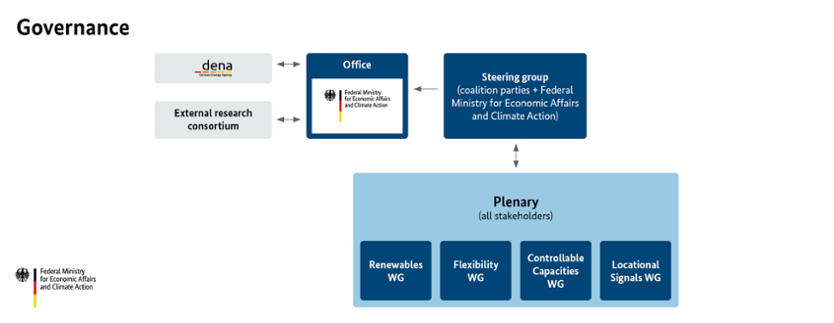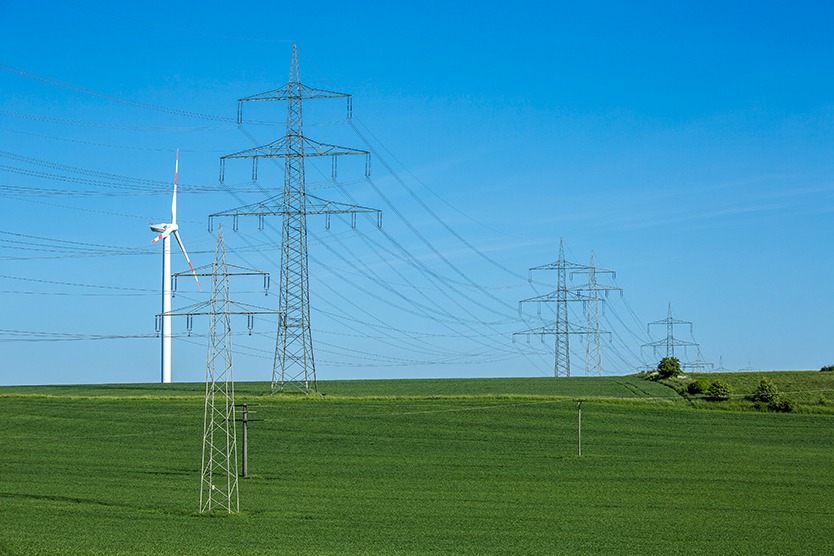How will the proposals of the Climate-Neutral Electricity System Platform be drawn up?
|
The Climate-Neutral Electricity System Platform brings business, politics, civil society and science together to find solutions for the electricity market design of the future. |
The composition of the platform:
The Climate-neutral electricity system is a broad-based platform in which various interest groups from the areas of the energy business, consumption, industry and civil society participate. Policymakers are represented by participants from coalition parties and the Länder. The relevant ministries of the Federal Government and federal authorities are also involved. The platform is supplemented and supported by members of scientific institutions.
The structure of the platform:
The plenary in which all stakeholders are represented forms the heart of the platform. A thematic working group (WG) is to be formed for the discussion of each one of the Climate-Neutral Electricity System Platform’s four forward-looking questions and these will be made up of the platform’s participants. A steering group composed of representatives from the coalition parties will support and direct the process at political level. The Climate-Neutral Electricity System Platform will be organised by an office of the Federal Ministry for Economic Affairs and Climate Action. The German Energy Agency (dena) will support the Federal Ministry for Economic Affairs and Climate Action in the organisational aspects of the platform. In addition, specialist scientific support will be provided by a broadly positioned consortium comprised of Guidehouse, Consentec, Fraunhofer ISI, Neon, Öko-Institut (Institute for Applied Ecology) and r2b energy consulting.

© BMWK
The functioning of the platform:
The Climate-Neutral Electricity System Platform is a forum for continuous and results-oriented discussion on the future electricity market design. Within an open process, debate will be thematically focussed and led in a task-oriented manner. The process will be flexibly structured so that the latest developments can be taken into account. The Climate-Neutral Electricity System Platform depends on the interactions between the various stakeholders and the exchanging of different perspectives. The support of scientists and experts will bolster the high level of specialised discussion.
In addition to the plenary meetings on overarching questions, the WGs will convene to discuss their respective thematic areas and where necessary, also hold cross-WG meetings. Interaction between the topic clusters is inherent and will be taken into account in the process.
The content and findings of the discussions will be published by the Federal Ministry for Economic Affairs and Climate Action on this website. Additionally, according to current plans, a first report on the status of discussions and results already obtained is to be presented in the summer of 2023. A further report will follow in the winter of 2023/24.
What topics does the Climate-Neutral Electricity System Platform address?
|
The Climate-Neutral Electricity System Platform focuses on four fields of action: renewable energy, flexibility, secured capacity and locational signals. |
The Climate-Neutral Electricity System Platform picks up on the most important questions surrounding the design of the future, largely climate-neutral electricity system and its market design.
WG 1: Ensuring the Funding of Renewable Energy
The Funding Renewables WG deals with the question of how incentives for renewable energy installations in a climate-neutral electricity system can be secured, i.e. for sufficient deployment and operation that serves the system. The focus of the discussion here is on the period after the complete realisation of the phase-out of coal, during which the deployment of renewables is to be as market driven as possible. The key question will be the extent to which the energy-only market or a different market design can set the necessary incentives to also invest in renewables in the future.
WG 2: Expansion and Integration of Flexibility Options
The Flexibility Options WG examines the question of how flexibility options might be used for system balancing and integrated into the electricity system, and the obstacles and barriers that have to be removed for this to happen. The focus here is on demand-side flexibility options including energy storage in the industry, commerce, trade and service sectors and in households.
WG 3: Funding of Controllable Capacities to Cover Residual Load
The Funding of Controllable Capacities WG is concerned with the question of how the needs-oriented supply for consumers can also be maintained in times of high residual load. This means ensuring security of supply in times when there is no wind or sun, and electricity generation from renewables is therefore insufficient to cover demand.
WG 4: Locational Signals
The Locational Signals WG deals with regional and local price signals. In the new electricity system, renewable energy needs to be transported across long distances and integrated into the transmission and distribution grid. Grid expansion is therefore the top priority. Nevertheless, discussions must be held on whether and how, in an electricity system that is based largely on renewable energy sources, there have to be locational price signals that support better regional load management and represent the grid better on the market. A complete expansion of the power grid that is free of congestion is not possible and would also not be efficient. That said, curtailments of renewable energy should be as infrequent as possible. Locational signals can be instrumentally depicted in diverse ways, for example, via the grid fee system, measures for the use of flexibility that serves the system, in national funding schemes, in redispatch or in the electricity market. This working group will address signals both at the level of the transmission system and the distribution grid, and discuss all options in an open-ended manner.
What happens with the findings of the Climate-Neutral Electricity System Platform?
|
The findings of the Climate-Neutral Electricity System Platform are an important basis for political decisions in Germany and Europe. |
The developed proposals and options for the development of the electricity market design within the Climate-Neutral Electricity System Platform are an important basis for the drafting of specific adjustments to the regulatory framework for the electricity market.
Because of Germany’s geographic position and its size, it is important to bear in mind the consequences of potential adjustments to the European single market for electricity. Germany shares a bidding zone with Luxembourg. Therefore, Luxembourg is also invited as a participant to the platform.
In its discussions, the platform will appropriately include the latest European proposals for a short-term, targeted reform of the European internal electricity market. A potential and more fundamental reform, requires an in-depth analysis. The platform can play a significant role here.
Further Information
Regarding the current discussion on the electricity market design on European level, Germany has published a joint letter together with six other member states. You can find it here.

